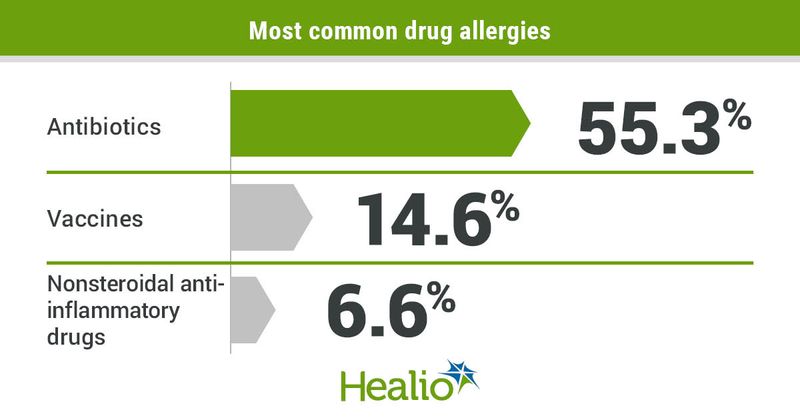Nearly one-third of patients with drug allergy fail to follow up with challenges
Key takeaways:
- 63.6% of patients consulted for drug allergy were recommended for more testing.
- 32.5% of these patients did not complete their visit.
- 92.9% of those who did follow up then passed testing and were de-labeled.
Even though most patients who were evaluated for a drug allergy were recommended for more testing, nearly one-third of them did not complete additional evaluation, according to a letter published in Annals of Allergy, Asthma & Immunology.
Also, most patients who followed up with further testing passed their drug allergy challenges, Monica T. Kraft, MD, assistant professor, division of allergy and immunology, department of otolaryngology, The Ohio State University Wexner Medical Center, and colleagues wrote.

“We had noted that since most patients seen for drug allergies in our clinic would need to return for a second visit in order to be tested for specific drug allergies, there was a risk of patients not following up for the second appointment and thus not having a complete allergy evaluation,” Kraft told Healio.

“Our goal was to identify how many patients were not returning for the second appointment for testing and see if there was a trend with any characteristics that might help us identify these patients in advance,” she said.
The retrospective chart review assessed 261 adults (77% women; 83% white) evaluated for drug allergies, with numbers of drug allergies ranging from zero (11.1%) to more than 10 (7.7%), although 75.5% of visits addressed a single allergy.
Antibiotics were most often assessed (55.3%), with penicillin leading the class (32%), followed by vaccines (14.6%) and nonsteroidal anti-inflammatory drugs (6.6%).
Initial consultations with the allergist led to recommendations for additional confirmatory testing such as skin testing with subsequent oral challenge or direct oral graded dose challenge for 166 patients (63.6%).
Also, 17.6% of patients were cleared of their allergy by history or had their allergy classified as a side effect or intolerance, 14.2% were instructed to avoid the drug because of a likely allergy and 2% were admitted for desensitization.
Among the patients who received recommendations to return for testing or challenges, 54 (32.5%) did not complete their visit. These patients also included 35 (65%) who never scheduled a follow-up appointment.
The researchers noted that there were no statistical differences between the patients who did or did not return based on age, sex, race, number of drug allergies or drug allergy class, nor were there any associations between drug allergy class and visit completion.
“We were surprised with how many patients were not following up for testing, essentially leaving their evaluation only half-completed in which the allergist had discussed the possibility of allergy but had not definitively ruled it in or out via available testing,” Kraft said.
“Unfortunately, we were not able to correlate any factors (demographic, medical or otherwise) with who was least likely to return, so we were unable to find any predictors for missing the appointment,” she said.
The 112 patients (67.5%) who completed a full evaluation included 104 (92.9%) who passed their testing and were successfully de-labeled, three (2.7%) who failed the challenge and five (4.5%) who had equivocal results.
“This is significant because now that the problem has been quantified, we can see exactly how many patients are not having a complete evaluation,” Kraft said. “We can now begin to work towards processes to help overcome any barriers to care these patients may have that prevents them from completing their testing.”
Inaccurate allergy labels can lead to increased health care costs as well as increased adverse effects due to suboptimal drug selection, the researchers cautioned, yet there are little data on follow-up rates among patients with drug allergy. With nearly a third of patients lost to follow-up in this study, the researchers said, there is potential for quality improvement.
“One obvious solution is to work to have testing completed on the same day as the initial allergy evaluation, although this poses scheduling challenges,” Kraft said.
For example, Kraft noted, not every patient requires allergy testing. Also, often when it comes to drug allergy, the specific medication in question needs to be ordered for a skin test or an oral challenge.
“Improved communication to relay the importance of the follow-up testing visit as well as reminders from the office may be beneficial,” Kraft continued. “We can also work to delve deeper into why patients are not following up for testing to identify any modifiable factors that are preventing their return.”
Since an understanding of why patients do not return would be crucial to improving follow-up rates, the researchers said, future studies should use direct interviews or questionnaires asking them why they do not return.
“The next step would be to dive deeper and find out the reasons why patients are not following up for their testing,” Kraft said. “Once the most common reasons have been identified, we can work to address those concerns and hopefully improve the follow-up rate, which ultimately will result in better medical care for these patients.”
For more information:
Monica T. Kraft, MD, can be reached at monica.kraft@osumc.edu.


